Email marketing is a powerhouse in today’s digital landscape, driving connections and conversions like never before. But what’s the secret sauce to making it work?
It’s all about knowing how to measure success in email marketing. Understanding this key aspect ensures you’re not just sending emails into the void but are hitting the mark with your audience.
So, let’s read on to explore beyond the horizon.
Table of Contents
- How to Measure Success in Email Marketing With Just 3 Steps
- What are the 4 Most Important Metrics in Email Marketing?
How to Measure Success in Email Marketing With Just 3 Steps
Yes, with just 3 steps! You read it correctly.
Here, I have arranged the whole email marketing success measure process in just 3 steps for you in the easiest way possible—no confusing tech talk—just precise guidance to help you measure your email marketing triumphs!
Let’s get started measuring your email marketing campaign.
1Create a Comprehensive Measurement Plan
Planning is key before starting any endeavor, including measuring email marketing success. To start the measuring journey, make a plan and follow some simple rules to keep your email marketing score healthy.
Take a peek at the plan I’ve laid out for you!
Fix Timing
Measuring the success of your email marketing campaign is not a one-time task. It’s an ongoing task that helps you understand how well your efforts pay off.
However, the question remains: how often should you do it?
The answer is simple: it’s entirely up to you! It’s your call whether you prefer to check weekly, monthly, or after each campaign. Just pick one and stick to it consistently.
So, in a nutshell, whether you’re tracking every week, month, or per campaign, remember to keep it regular.
Identify Your Goals and Objectives
You must have a goal and objective, which should guide your email marketing performance tracing. Your measurement approach should also align with these goals.
Your goals determine how measurable they are and the methods for tracking them. So, ensure your measurement strategy matches your objectives to accurately gauge your email marketing success.
Test Every Action
Experiment with different approaches and strategies and constantly test every aspect, from content to the timing of your emails. By doing so, you can understand how recipients react to different approaches.
This mail-testing strategy is vital to determining your audience’s interests and behaviors. It helps you pinpoint when your audience is most inclined to click on your emails and which types of content resonate best with them.
So, keep testing and refining to tailor your emails for maximum impact!
Implement Tracking Mechanisms
Email marketing and measuring its success is easier with the right tools. So, you must implement email marketing software that meets all your needs.
Editor's Recommendation: For an affordable and effective solution, try MailBluster. It's designed to seamlessly meet all your needs.
To track your audience’s responses accurately, consider the UTM parameters. These codes help you test your campaign’s success rate more precisely.
It is also important to adhere to data privacy regulations like GDPR (General Data Protection Regulation) or CCPA (California Consumer Privacy Act) when setting up tracking mechanisms. Respecting your subscribers’ privacy preferences is essential.
Lastly, I must add that investing in tracking resources can lead to more accurate results.
213 Key Metrics for How to Measure Success in Email Marketing
Next, to measure your email marketing success accurately, you need to understand the metrics and KPIs (Key Performance Indicators). I’ve compiled a list of 13 essential email marketing KPIs and metrics. These are,
| Open Rate | Click-through Rate |
| Conversion Rate | Unsubscribe Rate |
| Click Rate | Bounce Rate |
| Spam Score Rate | ROI |
| Forward and Sharing Rate | List Growth Rate |
| Device Statistics | Customer Lifetime Value |
| Cost Per Acquisition |
Let’s explore them in detail,
Open Rate
The open rate measures the percentage of emails you send compared to the number of unique opens by recipients during the specific time or campaign period. The mathematical formula is,
(Total number of email opens / total number of emails delivered) * 100 = Open Rate
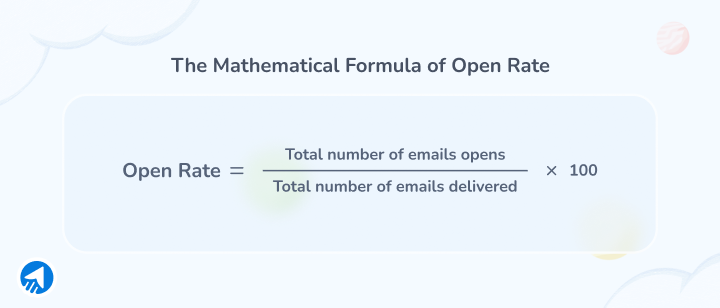
Suppose you choose to measure your email marketing success intervals, like every 15 days. So, pick the number of emails sent and unique opens from the previous 15 days and apply the formula. You will find the open rates for that interval period.
However, note that some platforms may count re-opens as initial opens, which could inflate the number. In this case, the accurate open rate will be slightly lower than the actual indicated data.
Comparing your open rates between different periods helps you see what strategies are working.
Pro Tip: The 2 tricks to increasing your open rate are writing personalized and engaging subject lines that are short and easy to read and understand. Because subject lines are the first thing a recipient sees in an email.
Another is sending emails during peak times, typically between 9:00 a.m. and 12:00 p.m. on weekdays.
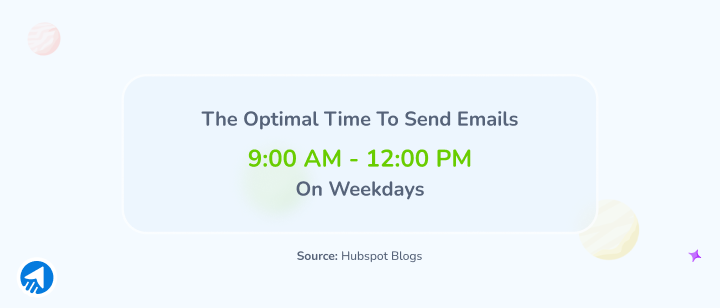
Click-through Rate
Click-through rate (CTR) is a crucial email marketing metric, much like the open rate. It measures the total number of unique clicks on your anticipated link by the email recipients, thereby indicating the effectiveness of your email campaign.
The total unique clicks are divided by the total sent emails in a particular period and then multiplied by 100 to bring the CTR in percentage. The mathematical formula is,
(The total number of clicks / the total email delivered) * 100 = CTR

CTR is not just a metric; it’s a barometer that measures your email’s usefulness, timeliness, and interest to your recipients.
But what if your CTR isn’t hitting the mark? Don’t panic! Instead, see it as an opportunity to jazz up your email. Tweak your email to make it more personalized and irresistible. Here, the CTR of your email can play a significant role in conducting A/B testing.
Pro Tip: Don’t overwhelm your recipients with too many links in your email. Keep it simple and focused. Some exceptional approaches can be different, like promoting many items for purchase or sharing multiple resources.
Conversion Rate
Conversion rate is the fundamental metric in any marketing method. In email marketing, the conversion rate is the percentage of the total number of recipients from delivered emails that did what you wanted them to do (like sign up, buy something, or subscribe)
The calculation of the conversion rate is straightforward. It’s the total number of conversions divided by the total number of emails delivered. Then, you multiply that by 100 to get the percentage. In mathematical terms,
(Total number of conversions / total number of email delivered) * 100 = Conversion Rate
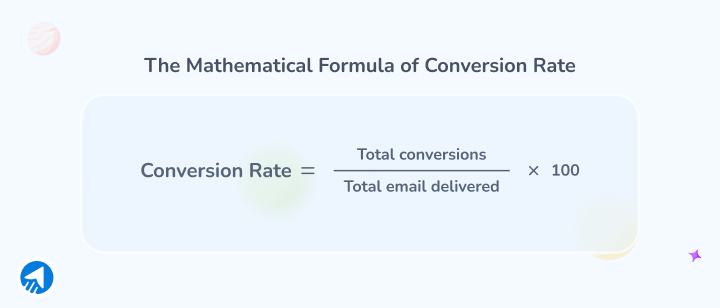
Let’s say you sent 1000 emails, and 600 recipients did what you asked. In this case, your conversion rate is (600/1000)*100=60%.
Now, what counts as a “conversion” can vary depending on your goals: it could be a lead magnet form, subscription, purchase, sign-up, or even clicking on a link. However, the key to boosting your conversion rate is making your emails persuasive and easy to act on. Think of it like giving someone a friendly nudge in the right direction.
Pro Tip: To monitor your conversion rate, integrate Google Analytics into your website or send an email with a unique tracking code.
Unsubscribe Rate
The unsubscribe rate is also an important metric for measuring success in email marketing. Unsubscribe is when any lead opts out from your email list from the given email.
A higher unsubscribe rate does not indicate a healthy score like open rates. It’s essential to monitor and address any increase in this rate after a campaign or marketing emails, as it could be a sign of disengagement from your audience.
Learn about unsubscribe link and how to add it in an email.
It can be measured simply by dividing the total number of unsubscribers by the total emails delivered, then multiplying by 100 to get the percentage. In the mathematical equation, it is,
(Total unsubscriber / total email delivered) * 100 = Unsubscribe Rate
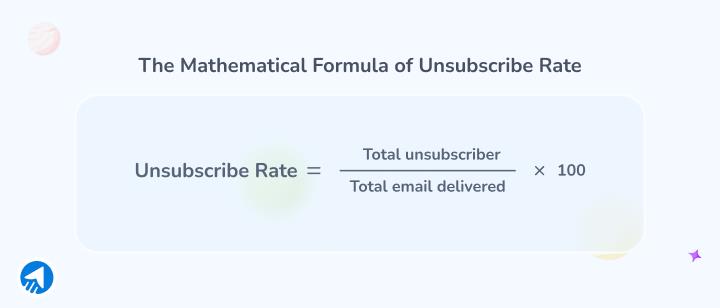
Unsubscriptions can happen due to too many marketing emails or irrelevant email content to audiences.
Pro Tip: One effective way to reduce the unsubscription rate is to listen to your subscribers. Consider asking them how often they would like to hear from you and what type of content they find most valuable.
Another effective way is to implement double opt-in in your email marketing strategy.
Learn more: 5 Opt-in Email Marketing Examples and Best Practices That Drive Results.
Click Rate
Click rate is how many people clicked on your email out of how many emails you have delivered in a campaign or time. It is easy to calculate; divide the total clicks by the total emails delivered, and then multiply the answer. The formula will look like,
(Total unique clicks / Total email delivered) * 100 = Click Rate
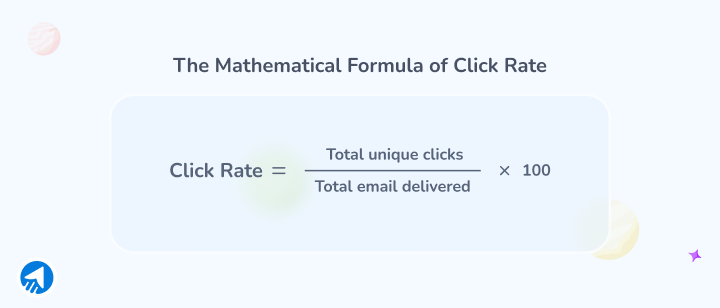
For example, if you sent 500 emails and 25 recipients clicked on a link, the click rate would be 5%.
Click rates are generally more accurate than open rates. They are recorded when a user clicks on a link within the email. However, some security measures, like link scanning by email clients or antivirus software, may artificially inflate click rates.
Bots or automated systems may click on links, leading to inflated click rates. This is more common in certain industries or regions.
Pro Tip: To get the most accurate click rate data, implement a click tracking mechanism that filters out bot activity and automated link scanning.
Bounce Rate
In email marketing, a bounce happens when your email doesn’t reach its intended recipient due to various reasons, such as server issues, full inboxes, or incorrect, inactive, or non-existent information. This means your email “bounces back” to you.
To calculate the bounce rate of your email marketing, divide the number of bounced emails by the total emails sent and multiply by 100. The formula looks like this—
(Total bounced emails / Total attempted emails) * 100 = Bounce Rate
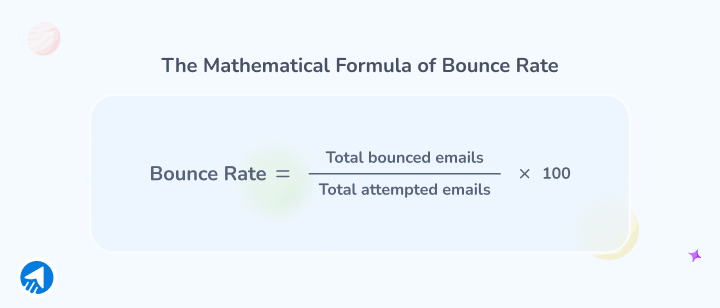
While bounce rates might not seem crucial for success in email marketing, they can affect your email sender’s reputation with internet service providers (ISPs).
There are 2 types of bounces: soft and hard. A soft bounce is temporary and usually occurs when the recipient’s email server is down or the inbox is full. It won’t hurt your sender’s reputation.
However, hard bounces are serious and happen when an email address is incorrect or inactive. They can damage your sender’s reputation and increase the risk of your emails being marked as spam.
Pro Tip: While building your email list or asking for a subscription, make sure to implement a double opt-in strategy. This ensures email addresses are correct and that recipients want to hear from you. It not only reduces your bounce rate but also helps you avoid being seen as a spammer when sending bulk emails.
Learn more: Email Security Guide: How to Stop Email Spoofing
Spam Score Rate
The spam score rate, or spam complaints rate, happens when recipients mark your marketing emails as spam, report phishing, or block you.
This typically occurs when recipients feel your email isn’t relevant to their interests, and they can’t find the unsubscribe button.
The more your recipients mark you as spam, the more your sender reputation suffers. On average, a spam complaint rate of 0.1 or 1 out of 1000 emails is considered acceptable. More than this, ALERTING!
So, the spam score rate is calculated by dividing the total spam reports by the total emails sent and multiplying by 100. The formula looks like this—
(The total spam report / total email sent) * 100 = Spam Score rate
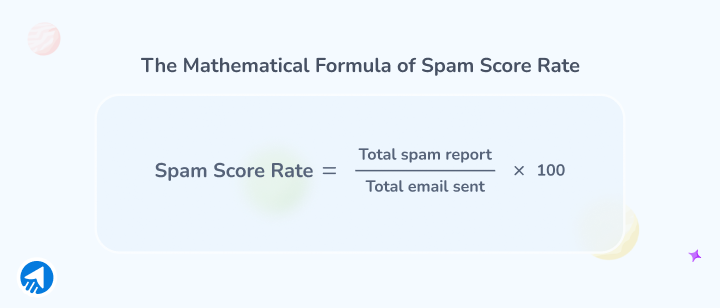
Pro Tip: Avoid purchasing email lists from third parties, as this can increase your spam score. And send emails from the same domain that subscribers willingly signed up for. This helps maintain a positive sender reputation and reduces the risk of being marked as spam.
Return on Investment
Return on investment, in short ROI. If email marketing is still alive in the competition with social media marketing, it is only because of the overall ROI of email marketing. On average, for every $1 invested, email marketing generates $36 in returns, making it incredibly profitable.
Read Email Marketing vs Social Media Marketing: Head-to-Head Comparison
ROI in email marketing can be calculated in many ways; I will show you the easiest and most accurate one that I use for my email marketing campaigns. So, the calculation is to subtract your total spending from the additional sales revenue generated by your campaigns. Then divide the answer by the total spending again and multiply by 100.
I know it is a bit confusing, but the mathematical formula will help you out,
{(Total revenue - Total email costs) / Total email costs} * 100 = ROI

For example, if you spend $1000 and gain $30,000 in additional sales, your ROI would be, {(30,000 – 1000) / 1000} * 100 = 2900%
Pro Tip: Ensure alignment between your marketing and sales teams by establishing a clear service level agreement (SLA). This helps assign value to leads and maximizes revenue potential for your company.
Forward and Sharing Rate
Measuring success in email marketing goes beyond open and click rates. Forwarding and sharing rates are key indicators of brand awareness and audience engagement.
Well, forwarding and sharing in email marketing is when recipients pass on your marketing or campaign emails to others, essentially creating indirect word-of-mouth marketing.
One of the key advantages of this calculation is the potential to acquire a new email list for your marketing or campaign emails at no additional cost. Moreover, this list is guaranteed to be 100% interested in your product or service, maximizing your marketing efforts.
So, find it beneficial? Let’s calculate it now. Calculating the forward and sharing rate is simple: divide the total forwards and shares by the total emails delivered and multiply by 100. The formula is,
(Total Forward and/or share / total email delivered) * 100 = Forward and Sharing Rate
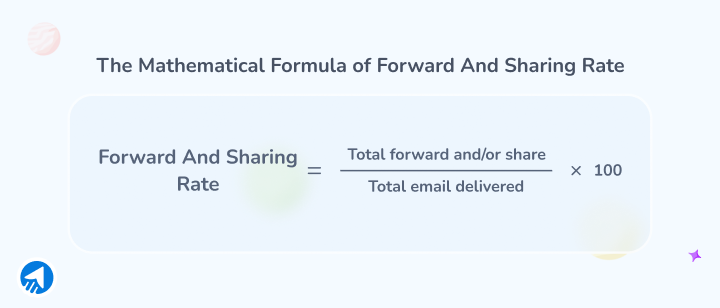
Pro Tip: Personalize your content strategically to improve the forward and sharing rate of your email marketing. Identify the type of content that resonates most with your audience and encourages them to share it with others.
List Growth Rate
The list growth rate is also a vital KPI for measuring success in email marketing. It helps you understand whether your email list is growing or decreasing over time, and it is very important to continually grow your email list.
Learn How to Build an Email List for Free: 30+ Proven Ways
Surprisingly, approximately 25.74% of emails from your list degrade each year. This KPI clearly shows how crucial it is in measuring email marketing effectiveness.
Here’s how to calculate the list growth rate—
Subtract the number of unsubscribes from the number of new subscribers, then divide the answer by the total contacts (at the start of the period). And then multiply the outcome by 100 to bring it in as a percentage. The mathematical formula is,
{(Total new subscribers - Total unsubscribers) / Total Contact} * 100 = List growth rate
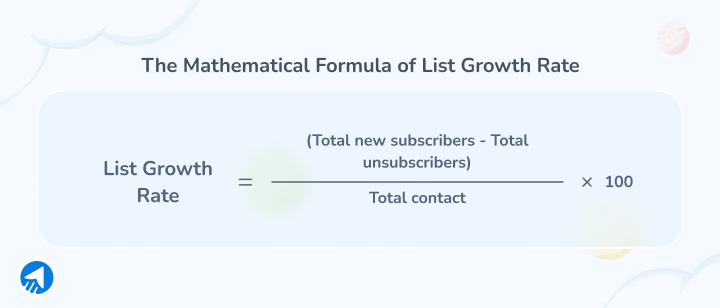
Pro Tip: A 1-3% list growth rate per month is a healthy rate for email marketing. Clean your list regularly and fine-tune your opt-ins to ensure a healthy list growth rate.
Device Statistics
Identify which device your audience prefers for opening and acting on emails. Then, optimize your email template, content, and CTA to be device-friendly.
Check out your email marketing platform to see if it offers you device-specific template optimization. A seamless experience across devices is vital—losing a recipient due to an unfriendly interface can derail your strategy. So, it’s crucial to identify and adapt accordingly.
Mobile Friendly Email: Tips to Make Your Email Mobile Responsive
Pro Tip: Regularly test your email templates across different devices and screen sizes to ensure optimal rendering and usability. Request feedback from your subscribers to understand their device preferences and any issues they encounter.
Customer Lifetime Value
In email marketing, customer lifetime value (CLV) is also known as email subscriber lifetime value. Here, the value is calculated not to find the profits the customer brings but to the additional profit the email subscriber represents.
To calculate the lifetime value of your email subscriber, multiply the profit you made from average active subscribers by the average lifetime of a subscriber. The mathematical formula is,
Profit from Average Active Subscribers * Average Lifetime of a Subscriber = Subscriber Lifetime Value
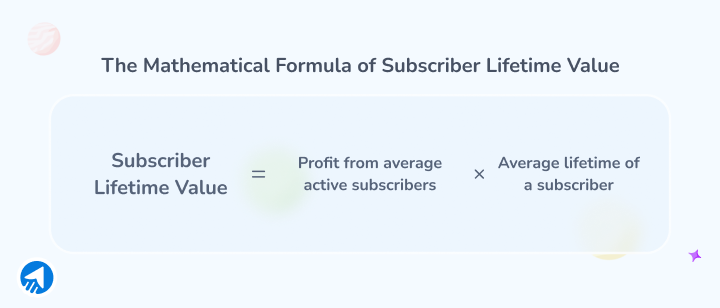
Pro Tip: Regularly analyze and segment your email list to identify high-value subscribers. Focus on enhancing customer satisfaction and loyalty through personalized experiences and exclusive offers, maximizing each subscriber’s lifetime value.
Cost Per Acquisition
Cost per acquisition (CPA) is a marketing metric that indicates the total cost to acquire 1 converted customer from a campaign. In email marketing, CPA is the total cost of running a campaign to acquire a single customer at a given time.
This math is very simple to do it is,
Total campaign cost / Total conversions = CPA

Pro Tip: Monitor and optimize your email marketing campaigns to improve performance and cut costs where possible.
3Analyzing Email Marketing Data
It is time to analyze how to make sense of the metrics we have gathered so far and use that understanding to refine the strategies. Here’s how we can do it—
Interpreting Comparative Performance
Don’t jump to conclusions or assume which of your email marketing efforts is driving the most success for your business based on a single metric at a specific time. Instead, regularly collecting and analyzing metric data over time is important. Then, compare these metrics between different periods.
Take note of when KPIs improve and seek to understand why. This analysis will help you identify trends and patterns, allowing you to develop your email marketing strategy accordingly.
Understanding User Behavior
Measuring email marketing success isn’t just about looking at KPIs. We also need to consider user behaviors.
These behaviors can vary widely, from content, color, and font preferences to the email interface itself. Understanding what resonates with your audience and how they prefer to engage is important. Once you have this insight, you can customize your email efforts accordingly, ensuring they hit the mark with your audience.
Optimizing Strategies
The final step is to optimize your email marketing strategy to determine which approach reaches your audiences successfully and whether they enjoy your email copy to take action forward.
Analyzing the data gives you a clear picture of which approaches and strategies bring positive outcomes. Then, you can tweak your approach according to the outcome to get even better results.
What are the 4 Most Important Metrics in Email Marketing?
We’ve learned 13 key email marketing metrics to measure success, but do you know which 4 are the must watch metrics to determine how to measure success in email marketing?
Well, the answer is short and will not drag the topic further. The 4 most important metrics in email marketing are,
- Open Rate,
- Click-through Rate,
- Conversion Rate, and
- Unsubscribe Rate.
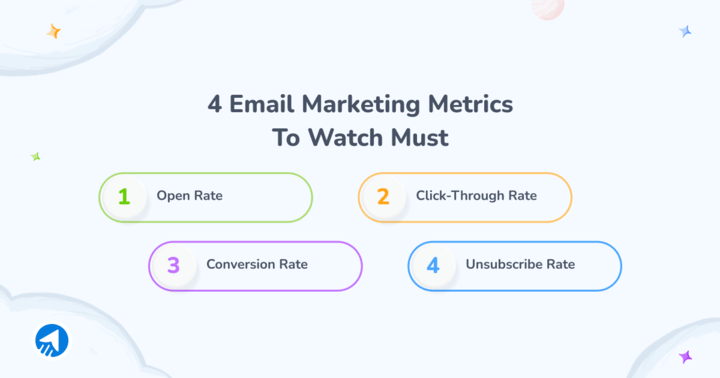
Wrapping Up
In wrapping up, mastering how to measure success in email marketing goes beyond just looking at numbers—it’s about truly understanding your audience, fine-tuning your strategy, and being flexible. Focusing on key metrics lets you see how well your campaigns are doing and make smart decisions to improve them.
Remember, email marketing isn’t just about sending emails; it’s about building real connections and giving value to your audience. Explore and try new things with these insights, and watch your email marketing shine!



 Contents
Contents
